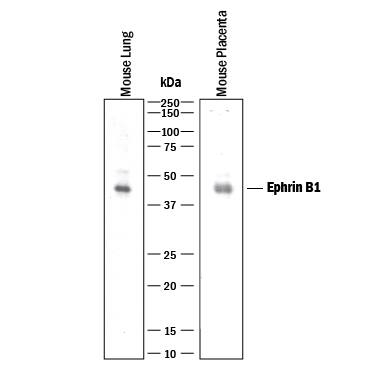Mouse Ephrin-B1 Antibody
R&D Systems, part of Bio-Techne | Catalog # MAB4731

Key Product Details
Species Reactivity
Validated:
Cited:
Applications
Validated:
Cited:
Label
Antibody Source
Product Specifications
Immunogen
Lys30-Ser229
Accession # AAA53231
Specificity
Clonality
Host
Isotype
Scientific Data Images for Mouse Ephrin-B1 Antibody
Detection of Mouse Ephrin‑B1 by Western Blot.
Western blot shows lysates of mouse lung tissue and mouse placenta tissue. PVDF membrane was probed with 1 µg/mL of Rat Anti-Mouse Ephrin-B1 Monoclonal Antibody (Catalog # MAB4731) followed by HRP-conjugated Anti-Rat IgG Secondary Antibody (Catalog # HAF005). A specific band was detected for Ephrin-B1 at approximately 45 kDa (as indicated). This experiment was conducted under reducing conditions and using Immunoblot Buffer Group 1.Applications for Mouse Ephrin-B1 Antibody
Western Blot
Sample: Mouse lung tissue and mouse placenta tissue
Formulation, Preparation, and Storage
Purification
Reconstitution
Formulation
Shipping
Stability & Storage
- 12 months from date of receipt, -20 to -70 °C as supplied.
- 1 month, 2 to 8 °C under sterile conditions after reconstitution.
- 6 months, -20 to -70 °C under sterile conditions after reconstitution.
Background: Ephrin-B1
Ephrin-B1, also known as LERK-2, ELK-L, EFL-3, Cek5-L, and STRA-1 (1), is a member of the ephrin ligand family which binds members of the Eph receptor family. All ligands share a conserved extracellular sequence, which most likely corresponds to the receptor binding domain. This conserved sequence consists of approximately 125 amino acids and includes four invariant cysteines. The B-class ligands are transmembrane proteins which can become tyrosine phosphorylated upon receptor ligation. The cytoplasmic domains are approximately 80 amino acids long and are highly conserved, especially the last 33 amino acids. Several signaling molecules have been shown to interact with the cytoplasmic region, although specific signaling roles have yet to be elucidated. Ephrin-B1 has been shown to bind EphA3, EphB1, EphB2, EphB3, and EphB4 (2, 3). The extracellular domains of human and mouse Ephrin-B1 share 94% amino acid identity. Only membrane‑bound or Fc-clustered ligands are capable of activating the receptor in vitro. Soluble monomeric ligands bind the receptor but do not induce receptor autophosphorylation and activation (2). In vivo, the ligands and receptors display reciprocal expression (3). It has been found that nearly all receptors and ligands are expressed in developing and adult neural tissue (3). The Eph/ephrin families also appear to play a role in angiogenesis (3).
References
- Eph Nomenclature Committee [letter] (1997) Cell 90:403.
- Flanagan, J.G. and P. Vanderhaeghen (1998) Annu. Rev. Neurosci. 21:309.
- Pasquale, E.B. (1997) Curr. Opin. Cell Biol. 9:608.
Alternate Names
Gene Symbol
UniProt
Additional Ephrin-B1 Products
Product Documents for Mouse Ephrin-B1 Antibody
Product Specific Notices for Mouse Ephrin-B1 Antibody
For research use only
